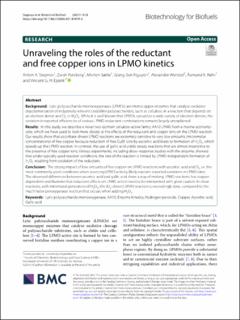| dc.contributor.author | Stepnov, Anton | |
| dc.contributor.author | Forsberg, Zarah | |
| dc.contributor.author | Sørlie, Morten | |
| dc.contributor.author | Nguyen, Giang-Son | |
| dc.contributor.author | Wentzel, Alexander | |
| dc.contributor.author | Kjendseth, Åsmund Røhr | |
| dc.contributor.author | Eijsink, Vincent | |
| dc.date.accessioned | 2021-05-18T12:56:28Z | |
| dc.date.available | 2021-05-18T12:56:28Z | |
| dc.date.created | 2021-02-05T08:51:40Z | |
| dc.date.issued | 2021 | |
| dc.identifier.issn | 1754-6834 | |
| dc.identifier.uri | https://hdl.handle.net/11250/2755507 | |
| dc.description.abstract | Background: Lytic polysaccharide monooxygenases (LPMOs) are monocopper enzymes that catalyze oxidative depolymerization of industrially relevant crystalline polysaccharides, such as cellulose, in a reaction that depends on an electron donor and O2 or H2O2. While it is well known that LPMOs can utilize a wide variety of electron donors, the variation in reported efciencies of various LPMO-reductant combinations remains largely unexplained. Results: In this study, we describe a novel two-domain cellulose-active family AA10 LPMO from a marine actinomy‑ cete, which we have used to look more closely at the efects of the reductant and copper ions on the LPMO reaction. Our results show that ascorbate-driven LPMO reactions are extremely sensitive to very low amounts (micromolar concentrations) of free copper because reduction of free Cu(II) ions by ascorbic acid leads to formation of H2O2, which speeds up the LPMO reaction. In contrast, the use of gallic acid yields steady reactions that are almost insensitive to the presence of free copper ions. Various experiments, including dose–response studies with the enzyme, showed that under typically used reaction conditions, the rate of the reaction is limited by LPMO-independent formation of H2O2 resulting from oxidation of the reductant. Conclusion: The strong impact of low amounts of free copper on LPMO reactions with ascorbic acid and O2, i.e. the most commonly used conditions when assessing LPMO activity, likely explains reported variations in LPMO rates. The observed diferences between ascorbic acid and gallic acid show a way of making LPMO reactions less copperdependent and illustrate that reductant efects on LPMO action need to be interpreted with great caution. In clean reactions, with minimized generation of H2O2, the (O2-driven) LPMO reaction is exceedingly slow, compared to the much faster peroxygenase reaction that occurs when adding H2O2 | en_US |
| dc.language.iso | eng | en_US |
| dc.publisher | BMC/Springer Nature | en_US |
| dc.rights | Navngivelse 4.0 Internasjonal | * |
| dc.rights | Navngivelse 4.0 Internasjonal | * |
| dc.rights.uri | http://creativecommons.org/licenses/by/4.0/deed.no | * |
| dc.subject | Gallic acid | en_US |
| dc.subject | Ascorbic acid | en_US |
| dc.subject | Copper | en_US |
| dc.subject | Hydrogen peroxide | en_US |
| dc.subject | Enzyme kinetics | en_US |
| dc.subject | AA10 | en_US |
| dc.subject | Lytic polysaccharide monooxygenase | en_US |
| dc.title | Unraveling the roles of the reductant and free copper ions in LPMO kinetics | en_US |
| dc.type | Peer reviewed | en_US |
| dc.type | Journal article | en_US |
| dc.description.version | publishedVersion | en_US |
| dc.rights.holder | © The Author(s) 2021. This article is licensed under a Creative Commons Attribution 4.0 International License, which permits use, sharing,
adaptation, distribution and reproduction in any medium or format, as long as you give appropriate credit to the original author(s) and
the source, provide a link to the Creative Commons licence, and indicate if changes were made. The images or other third party material
in this article are included in the article’s Creative Commons licence, unless indicated otherwise in a credit line to the material. If material
is not included in the article’s Creative Commons licence and your intended use is not permitted by statutory regulation or exceeds the
permitted use, you will need to obtain permission directly from the copyright holder. To view a copy of this licence, visit http://creativeco
mmons.org/licenses/by/4.0/. The Creative Commons Public Domain Dedication waiver (http://creativecommons.org/publicdomain/
zero/1.0/) applies to the data made available in this article, unless otherwise stated in a credit line to the data. | en_US |
| dc.source.pagenumber | 14 | en_US |
| dc.source.volume | 14 | en_US |
| dc.source.journal | Biotechnology for Biofuels | en_US |
| dc.source.issue | 28 | en_US |
| dc.identifier.doi | 10.1186/s13068-021-01879-0 | |
| dc.identifier.cristin | 1886976 | |
| dc.relation.project | Norges forskningsråd: 269408 | en_US |
| cristin.ispublished | true | |
| cristin.fulltext | original | |
| cristin.qualitycode | 1 | |

